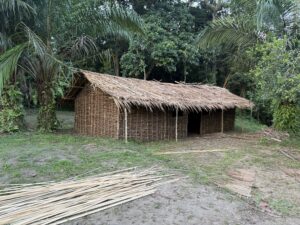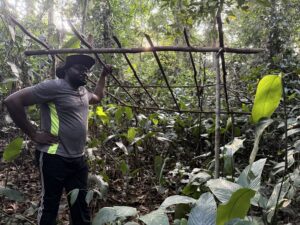Preparations at a BonDiv site, by Francesca Grillo
Martin and I were fortunate to arrive at a camp that had begun to take shape long before our arrival. It now serves as the base where WWF-DRC works to habituate bonobos, and we were warmly welcomed by the manager, the chef, and the trackers who have been tirelessly following these elusive and fascinating creatures.

To prepare for the work ahead, we first needed to find a suitable place to store our materials and samples. One of the newly constructed houses offers two rooms, one of which we quickly christened our new depot. Since we are within Salonga National Park, a UNESCO World Heritage Site, all the structures built at camp are made entirely from natural materials. In this case, Marantaceae stems (Haumania liebrechtsiana) and mud form the core of the buildings. The Marantaceae family dominates the rainforest understory in this region and serves many purposes, from food packaging to construction. The stems are bound together with lianas (Eremospatha haullevilleana) to create the house frames, which are then coated with mud for stability. Finally, the roofs are thatched with dried Raphia laurentii leaves, a simple yet effective shelter against the rain – our camp’s ever-faithful visitor.

One of the types of data collected during our study period relates to the climate. We monitor a pluviometer twice a day, a thermohygrometer once a day, and soil moisture data is recorded continuously. The pluviometer is placed at camp where there is sufficient open space, while the other sensors are installed deeper in the forest to better represent its microclimate. To protect the instruments, a small shed was built about 300 meters from camp, carefully maintaining the surrounding vegetation to ensure the readings remain as accurate and undisturbed as possible.
Since part of our work involves analysing bonobo faecal samples, we needed to find a suitable place to wash the samples in order to recover seeds, bones, and other important remains that shed light on their diet. The site had to be close enough to the river for easy access to water, yet downstream from camp and away from frequented areas so that our work would not cause any disturbance, whether hygienic or otherwise. After carefully selecting the spot, we built a small table to make the work easier. Dieu Merci and Bernard, two trackers at camp, kindly guided me through the process: showing me how to start the first tie, which knots to use when the liana becomes too short, and how to weave the stems together to form the sturdy base of the table.

As I write this, we are also preparing for a short deployment to the closest city, where we will introduce ourselves and our work to the relevant authorities and the local community. We are also planning visits to three nearby villages to begin another phase of data collection: social interviews with ten families in each of the three villages.
Once all this preliminary work is completed, we will begin collecting a wide range of ecological and biological data, including vegetation samples, water eDNA, bonobo faeces and urine, soil, ants, termites, blowflies, among others. We will also deploy both systematic and opportunistic camera traps to capture wildlife activity that we might never witness ourselves yet are just as vital to understanding the ecosystem around us.
October 2025, By Francesca Grillo, Species names provided by Martin Bofeko.